Within the pipework cleaning and flushing process, the chemical cleaning stage will be started after the dynamic flushing has been completed successfully, with the water quality and system parameters meeting the specification, requirements and being confirmed by the Chemical Engineer/Specialist.
If you have not seen our article 'FLUSHING & CLEANING | Pipework Systems Overview' or 'DYNAMIC FLUSHING | Procedure & Sequence' - they are the best places to start.
Below we will cover the chemical treatment process steps and information including inhibiting and passivation, prior to providing a link to our backflushing article.
What happens if the Dynamic Flushing is not completed successfully?
Starting the chemical cleaning prior to the dynamic flushing being completed successfully, will mean that the system will potentially still be contaminated with debris, dirt, and particles.
This will mean that the chemicals used in the cleaning process will not be as effective, meaning a large quantity is needed – costing a lot of money and time.
How much time can there be between Dynamic Flushing and Chemical Cleaning?
The general opinion is that between the two phases, there should not be any delays, the chemical cleaning should commence as soon as the Chemical Engineer gives the Ok.
If a delay occurs then there is a risk that the water within the system after dynamic flushing could start to go foul.
Where there is a delay or potential delay, the Chemical Engineer should be consulted to understand the steps needed to maintain the water quality and system to allow the treatment to take place in the future.

What are the roles and responsibilities for the chemical cleaning stage?
CxA | GENERAL CONTRACTOR | FLUSHING SPECIALIST | CHEMICAL ENGINEER
| General/Main Contractor | The general contractor should ensure that the chemical cleaning works are fully coordinated, the programme is being kept and everything is documented. They should also oversee the flushing and chemical specialists, and that they are performing their tasks properly. |
| Flushing & Cleaning Specialist | Provide advice, knowledge, expertise, resource, and equipment to ensure that this step is completed properly and successfully. |
| Chemical Engineer | Provide advice, oversee, laboratory tests, and supply the chemicals needed during the process. |
| Commissioning Manager | The Commissioning Manager [CxA] will, during this stage will be responsible for the review, check, and witness of the works to ensure that they are being completed in line with the approved documentation, method statement |
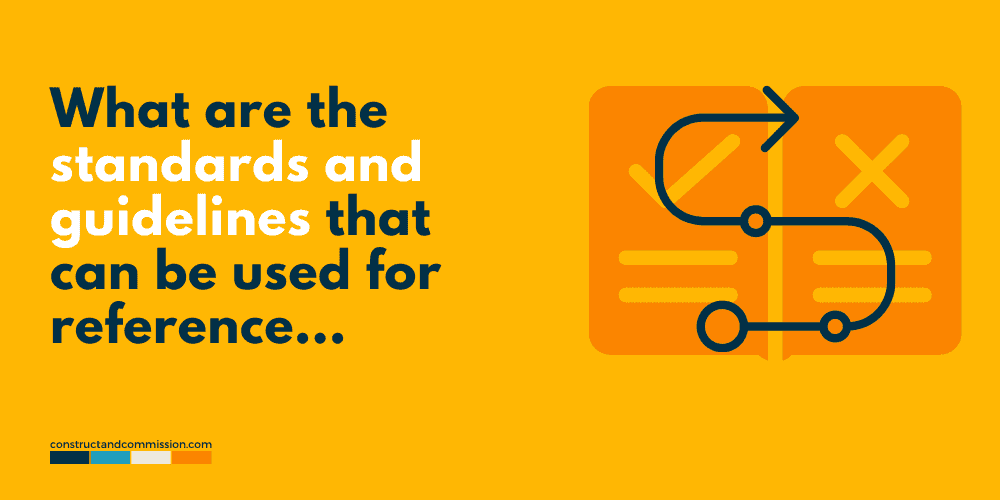
What are the Standards and Guidelines that can be used for reference
For the guidelines and standards that can be referenced, refer to the below:
- BSRIA BG-29 – Pre Commission Cleaning of Pipework Systems.
- BSRIA BG-50 – Water Treatment for Closed Cooling and Heating Systems.
- British Standard BS 8552 – Sampling and monitoring of water from building services closed systems.
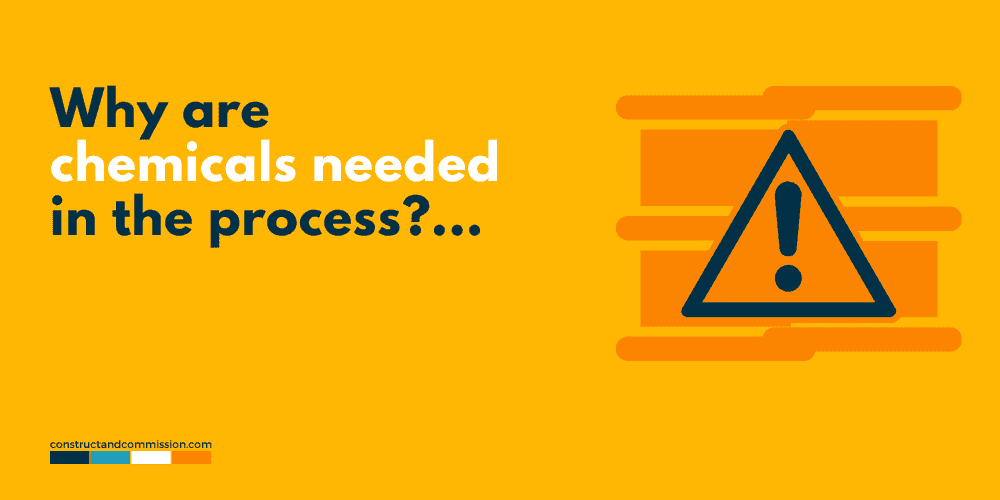
Why are Chemicals needed in the process?
Chemicals are used to clean, remove and then control the debris, fouling, and organic matter of a closed-loop system helping maintain its cleanliness from installation to handover and then for the life of the system.
If deposits are allowed to build up in the pipework and equipment it can start to cause the following issues, as noted in our previous article ‘FLUSHING & CLEANING | Pipework System Overview’
- General flow rate issues around the system due to accumulation of debris.
- Blockages at strainers.
- Issues with control valves.
- Coils are being blocked.
- Coils not operating at required design loadings.
- Increased maintenance and shortened life expectancy due to corrosion of terminal units, major equipment, ancillaries, and pipework that the water comes into contact with.
- Increased usage and costs of chemical treatment.
The deposits can create aeration and a concentration of cells which will usually result in localized corrosion that we have all seen, resulting in pitting and/or perforations of the pipework.
To see our full example of a method statement for the Flushing & Chemical Cleaning works, including the ongoing monitoring click here
Here is our Open Copy of our Flushing and Chemical Cleaning Method Statement in MS Word. With instructions
Common Types of Deposits
The most common deposits are from the following:
- Iron Oxide is the resultant reaction with the pipework material used and can be present in organic residues.
- Scaling from water hardness – Calcium [Ca] and Magnesium [Mg]
- Treatment chemicals and corrosion products, if not controlled and used properly can also cause deposits and scaling.
This is why need to make sure the Dynamic Flushing is completed properly, to remove the bulk of the above issues.
Selecting the Chemicals to be used
The Chemical Engineer will be responsible for specifying the chemicals, their types, and that they are selected in line with the type of system being cleaned and materials used.
The Chemical Engineer will consider the following regarding the selection of products and sequence they are to be used:
- The chemical should be able to disintegrate or dissolve deposits for removal by the flow of water around the system.
- Inhibition is needed in the chemical so as not to affect the base metals in the system.
- Should not be toxic or explosive, which would mean expensive removal and disposal.
Here are some common ones that would be considered:
- Biocide/Biodispersant – To reduce bacterial levels in the system water and help remove biofilms [depending on requirements of the system]. Usually called a biocide wash.
- Acid Cleaners– To aid the removal of surface oxides from the internal surface of the pipework.
- Complexing Agents – Chelants and Sequestrants, to aid scale removal
- Polymers/Dispersants – Used to break down any loose surface deposits to allow easy flushing to drain or catch in the filtration system.
- Neutralizers, Passivators, and Inhibitors/Biocide dosing – To manage the rate of corrosion within the system.
- Formulated cleaning products – To aid the removal of surface oxides from the internal surface of the pipework.
What is a Biocide Wash?
As noted above, if there is a lapsed period of time between the Dynamic Flushing and the Chemical Cleaning starting the water in the system may be contaminated.
The Chemical Engineer may determine that a Biocide Wash is required, via a bacteriological test, to clean up the system helping to control the bacteria and any biofilms that may have grown.
How do you use an Acid Cleaner?
Systems that are mainly constructed from mild steel [so most closed systems], will need to undergo an ‘Acid Clean’ to help with the dissolving and removal of scale and debris build-up.
Although there are options to use quite aggressive cleaners, they are generally not ideal for the flushing and cleaning process as the disposal can be complex and expensive.
So, the Chemical Specialist would usually specify ‘Organic Cleaners’ such as Formic, Acetic, or Citric Acid.
Citric Acid is usually the most common and should be paired with the appropriate ‘Acid Inhibitor’ to stop any problems with corroding the base metals in the system.
As the organic compounds are weaker they are usually used and blended with other chemicals during the process.
Again like with all chemicals the Chemical Engineer is the only person that should be selecting and specifying the chemicals used.
What is a Complexing Agent?
Complexing agents combine with the metallic ions in the system, once combined they form what is known as a ‘Complex Ions’.
There are two types of these:
- Chelants
- Sequestrants
Chelants ensure the metallic ions become difficult to ionize by complexing them into a ring structure.
Sequestrants change the metallic ions into a structure that allows them to be soluble in water.
Both will help with the removal of Scale from the system but should be noted that there could be certain temperature parameters that need to be met to allow the reactions to take place.
Polymers and Dispersing Agents
A polymer/dispersing agent is added to the cleaning process to help the separation and suspension of the loose surface materials, oil, grease, and films from the pipework and within the system to allow easy flushing to drain or until it is caught in the filtration system.
What is Neutralizaton?
During a cleaning process, if an inhibited acid cleaning chemical is used, there will be a risk, that even after the clean flush has been carried out, the inhibitor is lurking somewhere in the remote corners of the system.
To ensure the acid will not react with the system and metals a neutralizing solution, alkali, is used to ‘neutralize’ it and circulated around the system.
Why do you Passify the pipework?
Due to the chemicals and cleaning method used to ensure the system and pipework are cleaned, when it is completed the pipework surfaces will be left ‘bare and exposed’ to further corrosion.
Pacifying the pipework straight after the final flushing and before being put into use, handing it over to the facilities company and building owner will ensure that the system is not exposed to further corrosion.
To do this a ‘Passifying Agent’ will be used and circulated around the system.
We have been asked several times to create a complete document package covering everything we have uploaded to the site.
So it's taken some time, but here it is....126No. Documents for you to download in Microsoft Word, Microsoft Excel & PDF Formats.
CLICK THE BUY HERE TO SEE/DOWNLOAD A FULL LIST OF DOCUMENTS INCLUDED...
Biocide dosing requirements.
After all, flushing has been completed, inhibited, and passivated. The system should be dosed with biocide and corrosion inhibitors that will form part of the chemical dosing management of the overall operation of the system.
Ideally, the permanent chemical dosing and water treatment equipment for the system should be commissioned and in operation, logging and capturing the required data points for any proof and evidence of the system cleanliness.
What are Formulated Cleaning Products?
Formulated cleaning products are created by a chemical manufacturing company, taking multiple cleaning agents and ‘blending’ them together into one product combining them making life a little easier on site.
How do you Introduce Chemicals to the System?
There are generally * methods used to introduce the required chemicals into the system during the process:
- Using a chemical dosing pot.
- Using chemical drums and pumps.
- Adding to the temporary water tank [if being used].
What quantities of chemicals do I need?
The Chemical Specialist Engineer will advise and manage the chemical requirements and qualities based upon the system requirements.
Circulation Time of Chemicals
As noted in BSRIA, the general requirement for the circulation of chemicals around the system will range between 12 hours and 72 hours.
The time will be dependant upon many factors, and the chemical engineer should be responsible for providing their expertise in advising and sampling, and evaluating the system, instructing when to move to the next steps.
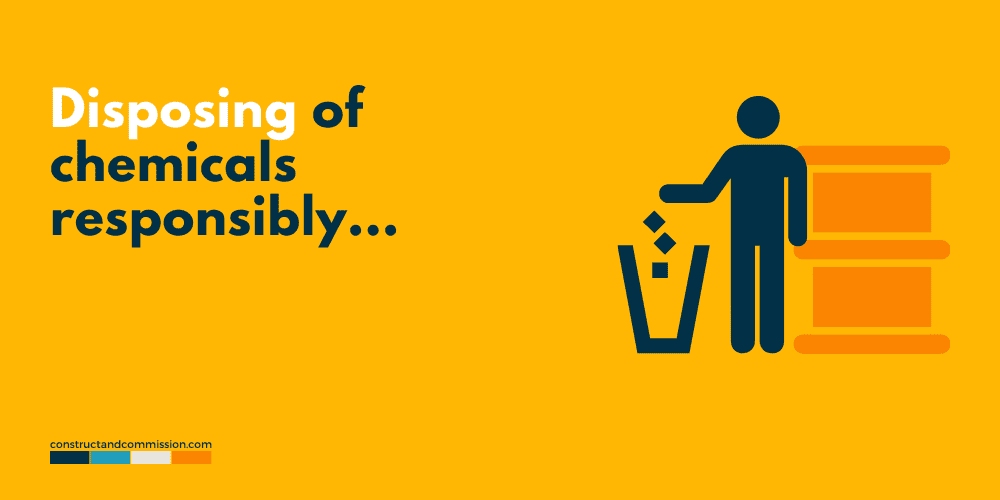
Disposing of Chemicals Responsibly
First thing on the disposal of chemicals – always check with the manufacturer of the chemical, obtain the datasheet, and review with any local / state-wide and utility authorities when it comes with discharging of chemicals.
There is normally a requirement to notify them and complete any paperwork and documentation to gain a permit/license to discharge.
Sometimes, depending on the system volume, there could be issues with the sheer quantity of water being disposed of.
Why a side stream filtration system is a much better solution than just flushing straight to drain.
Under no circumstances should any chemicals or flushing bi-products be sent to any surface drain, all, if allowed and approved, should be sent to the foul water drainage system.
If applying for a permit, some of the information that will be asked for would be, be mindful that sometimes there can be issues with the water discharge that could at worse case impact the programme:
- Location of site.
- Expected Start/Finish dates.
- Size/volume of the system.
- Types of chemicals being used.
- Data Sheets of chemicals.
- Expected discharge volume.
- Expected flow rate.
- The temperature of the water being discharged.
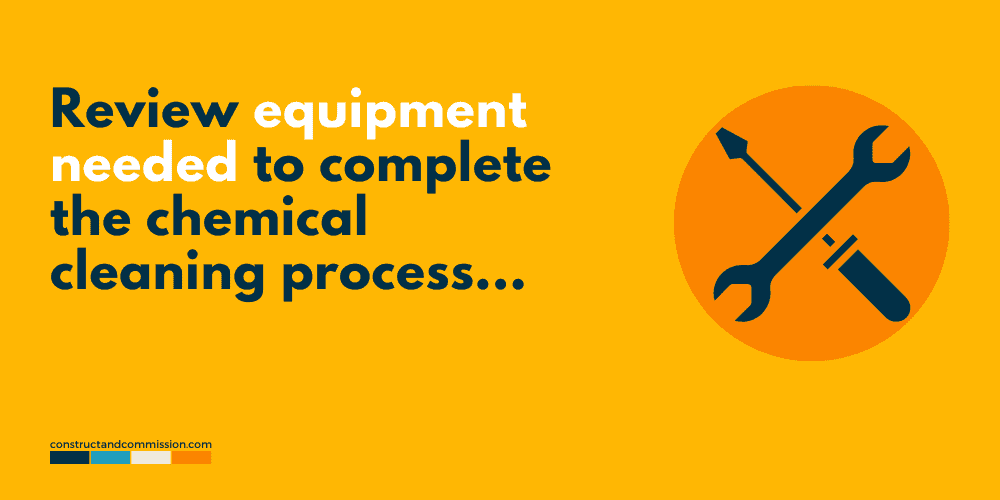
Equipment needed to Complete the Chemical Cleaning Process
The system should still be set up as per the Dynamic Flushing process.
So the following should be:
- Temporary mains water supply connection.
- Temporary drainage water connection.
- Connection to allow the introduction of chemicals.
- Temporary pumps [powered and piped].
- Flushing loops around equipment and terminal units
- Management of dead legs
- Clean strainers
- Temporary water tanks
- Temporary discharge tanks [if not allowed to discharge to drain]
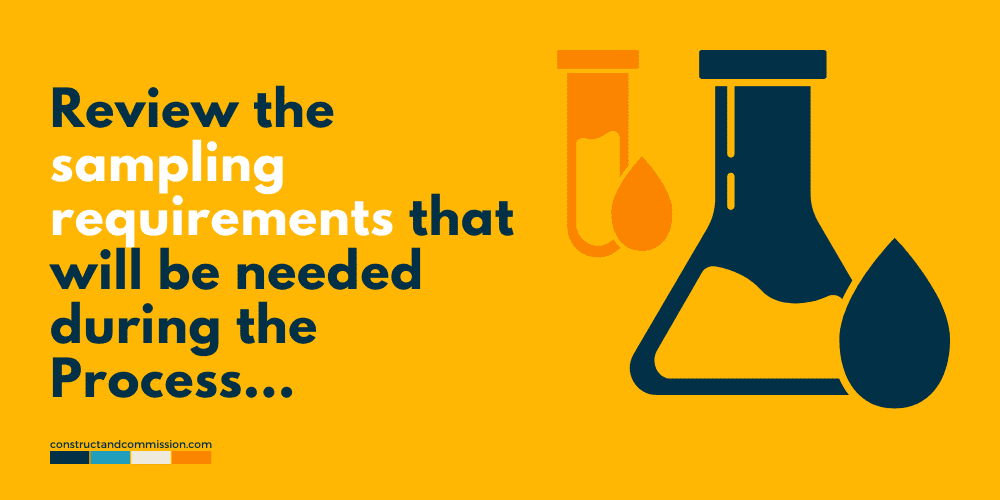
Sampling Requirements during the Process
Sampling will be required throughout the process to document and log that the water and system meet the requirements so that the next steps can commence.
The sampling will consist of monitoring the iron levels to ensure that they ‘plateau’ during the process.
This will be confirmed via onsite testing.
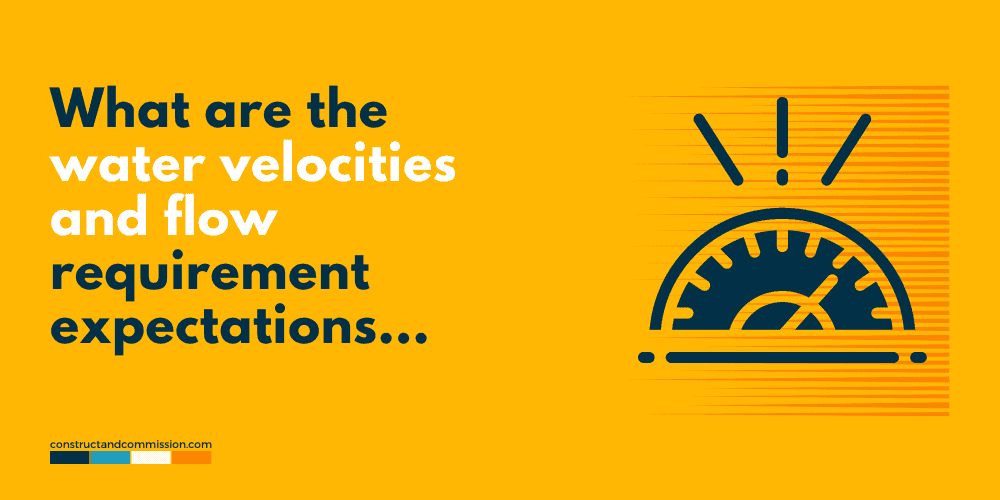
Water Velocities and Flow Requirements
The flow of water around the system, ensuring it gets to all the areas, is more important than the actual water velocity during this phase of the process.
Ensuring it flows to the correct places and covers the whole system will speed up the chemical cleaning and reduce the time needed for it to be successful.
If need to check any flow rates then these can be completed using the same methods as used in the Dynamic Flushing step before this.

Pre-Requisites to be completed prior to Starting
Use the pre-requisites as detailed in the Dynamic Flushing stage here.
Chemical Cleaning Steps
Once all the above has been completed and understood, the following steps should be completed:
Step 1 – Ensure the system is set up in line with the drawing
[add information based upon the drawing – valve positions and how to set it up].
Step 2 – Ensure the cleaning specialist has accepted the results from the dynamic flushing
Step 3 – Check that temporary drain valves & water supplies are closed
Step 4 – Ensure pumps are running and circulating water
Step 5 – Complete a biocide wash if Chemical Engineer advises
Step 6 – Chemical Engineer to introduce the chemicals to the system
Based upon the chemicals that have been selected by the engineer.
Step 7 – Chemicals to be circulated, the Chemical Engineer to monitor system and advise when complete
Monitoring iron levels to ensure they stabilize and plateau.
Continue to circulate the system, and take readings 2 hours apart to ensure are stable.
If the system is not stable, continue to circulate until are.
Step 8 – Conduct a Drain and Fill until the system water is of a similar quality to the water being filled.
Verify the similar water qualities by completing site sampling and testing for pH, Total Iron Increment, and Total Dissolved Solids.
Move to the next step once the chemical engineer has accepted the results.
Step 9 – With the pumps still running, close the temporary drain and water valves
Step 10 – Final Inhibition and Passivation chemicals added by Chemical Engineer
Step 11 – Circulate the water and chemicals for a time in line with the Engineers advice
Take multiple site samples of the system to check the condition of pH, Iron, and Total Dissolved Solids.
This is to check that the system is in line with expectations and specifications.
Step 12 – Circulate the system in line with Chemical Engineers advice
Chemical Engineer to provide status and confirm when complete
Step 13 – Take samples and send them to the laboratory for final analysis/documenting
Depending upon your specification, the analysis can cover the following types of quality metrics:
- Suspended Solids
- Conductivity
- pH
- Total Alkalinity
- Total Hardness
- Nitrates
- Sulfates
- Chlorides
- Total Iron
- Dissolved Iron
- Total Copper
- Molybdate
- Phosphates
- Glycol
- Total Viable Count [TVC]
- Pseudomonas
Step 14 – Ensure all documentation is fully completed, witnessed, and signed
This is important as will ensure that the activities are able to be proved later if any issues.

Backflushing of Terminal Units and Peripheral Equipment
For our article on the next step detailing the backflushing of equipment see our article ‘BACK FLUSHING | Procedure & Sequence’
Related Articles
FLUSHING & CLEANING | Monitoring after Flushing
CORROSION COUPONS | and Coupon Rack
FLUSHING & CLEANING | Pre-Works Check List
BACK FLUSHING | Procedure & Sequence
FLUSHING & CLEANING | Pipework Systems Overview
DYNAMIC FLUSHING | Procedure & Sequence


![Flushing & Chemical Cleaning Method Statement [MS Word]](https://constructandcommission.com/wp-content/uploads/2022/04/000-PH-Document-Graphic-Sell-3.webp)
